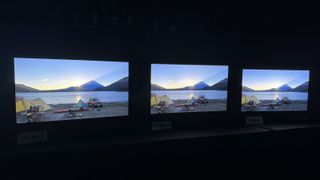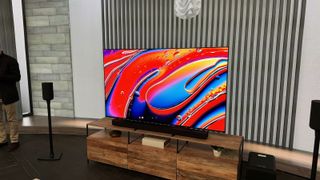The latest battleground in TV land is brightness, and leading the charge of the light brigade (sorry) is Sony. The Japanese brand is essentially fighting on two fronts (I’ll stop torturing this metaphor momentarily, I promise), with its new 4000-nit mastering-monitor infiltrating the movie industry and its new 4000-nit TV advancing on its way into homes.
I’ve been pondering how I feel about this since Sony first demonstrated its next-gen backlighting system to me at the end of last year, and I have to confess that I’m still not sure how I feel about it. I’ve been weighing up the arguments for and against in my head for months now, often when I should have been doing more important things such as sleeping or parenting, yet I’m still utterly torn. Perhaps explaining the arguments to you will help me figure out my own thoughts, sort of like tech therapy…
Bright and getting much brighter

Sony is, of course, far from alone in pushing brightness as the next great TV innovation. Samsung has been steadily raising the brightness bar with its QLED models for years, and recent advances in OLED (MLA and QD-OLED) have set the traditionally brightness-limited technology on a path to dazzling new heights.
Sony, though, is now raising the bar substantially further than any of its rivals, and its reasons for doing so are pretty compelling. It says that the increasing availability of 4000-nit mastering monitors (primarily its own, of course) means there will soon be an increase in movies mastered to that level, and you will need a similarly bright TV at home if you want to watch those movies as the director intended. It also says that in home conditions in which there’s often at least some ambient light, a TV needs to increase the brightness of a movie or TV show (or game, for that matter) beyond the limit to which it was originally mastered in order to maintain the intended effect.
Let’s tackle the second one of those first, because it’s arguably the more straightforward. Yes, it is definitely true that there is a big difference between 1000 nits in a dark room and 1000 nits in a bright room. I always argue that if you care enough about how a movie looks to be reading a story on the internet about nits, you should also care enough to watch it in the dark, but I do understand that that isn’t always possible. In which case, yes, having the TV compensate for ambient lighting by brightening the movie beyond the brightness at which it was mastered is a very good idea. In fact, I do this at home.
In my experience, though, you don’t need the brightness to be boosted by thousands of nits in order to compensate for the amount of ambient light in a typical, or even very bright, living room. My roughly 1000-nit Panasonic OLED actually does a great job in this regard, so a 4000-nit TV doesn’t feel necessary for the sub-1000-nit content we all watch today.
Are 4000-nit movies on the way?

Which brings me on to the bigger, less straightforward point: are we about to see an influx of much brighter movies and TV shows? I spoke to some of Hollywood’s most influential colourists earlier this year and they certainly didn’t think so; but I agree with Sony that some pioneering directors who take every opportunity to push the envelope will almost certainly leap at the opportunity afforded by the broad availability of Sony’s new mastering monitor. Are the next masterpieces by Scorcese, Villeneuve and Nolan going to be mastered to 4000 nits? I’ll eat my Panasonic OLED if they are. But you can well imagine James Cameron, Michael Bay and Joseph Kosinski releasing super-bright movies in the coming years.
And, of course, I will want to watch those movies as those creators intended. I’m not going to get into an argument over the cinematic merits of an Avatar or Top Gun versus a Dune or an Oppenheimer – if I’m bothering to watch a movie at all I want to watch it the way it’s supposed to be seen, at least as much as is possible at home. To me, that’s sort of the whole point and the reason I got into the business of TV and AV reviewing in the first place.
That causes me to lean gently towards the 4000-nit TV argument. The problem is that these movies don’t yet exist and I’m not desperate to buy a 4000-nit TV for the very few super-bright movies that are already out (if I ever watch Pan again, it will be too soon). So perhaps the real question is whether Sony has simply gone too early with its 4000-nit TV? Naturally, that won’t be an issue if said TV is excellent regardless of brightness, and it certainly looked very good in my Sony Bravia 9 hands-on session. The price is much lower than I expected, too.
We will know for sure how good the Bravia 9 is when we fully review it in the coming weeks, but I suspect we’ll be waiting much longer before we know to what degree we really need a 4000-nit TV. I look forward to flip-flopping in my opinion many more times between now and then.
MORE:
Here's my hands-on with the Sony Bravia 9
This is what the busiest colourists in Hollywood had to say about super-bright TVs
These are the best TVs you can buy right now.

